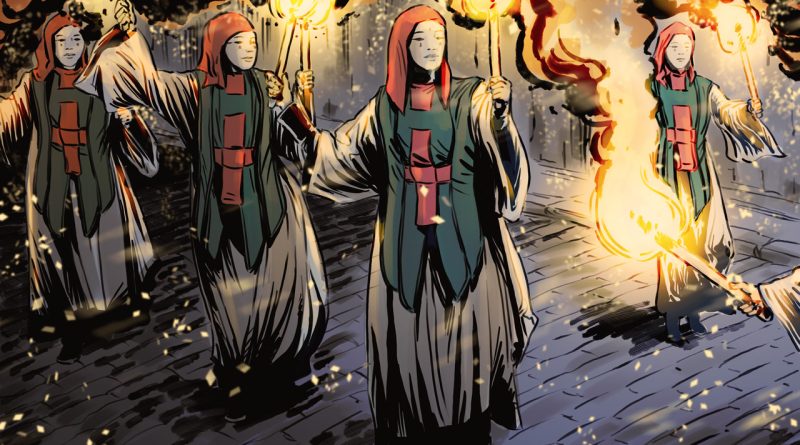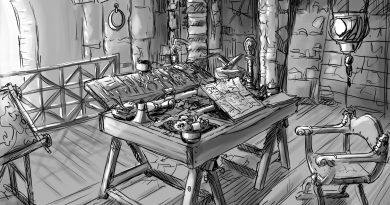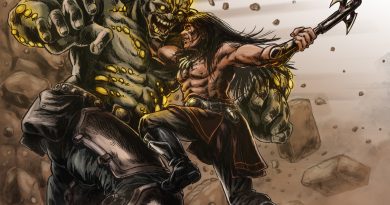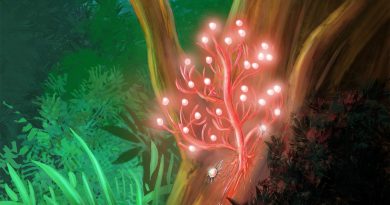Daily life, part 1 to 3
We don’t bury our dead, Anis, we burn them. There must be nothing left of them, let them be nothing but spirit and join the Stars, with those we have loved and who watch over us. We don’t mourn them, we don’t build them graves or monuments. Only the memory remains, which we take with us and cherish. And sometimes, because even with their virtues, our souls are weak and in need of comfort, we pray to them and hold close to our hearts objects that we treasure and that remind us a little of what they were when they were alive.
The Songs of Loss, The Arcis Forest
Daily life of the Lossyans
There are fourteen different peoples around the Seas of Separation, and at least as many cultures, customs, rites and beliefs, not counting those of local subcultures. It would be impossible to list them all, so we’re going to focus on what unites Lossyans, rather than what differentiates them, in their daily lives.
The following reference is to Concilian culture, the name given to peoples who have been under the influence of the Church for a thousand years. We’ll sort by theme: death, birth, men and women, gender and sexuality, childhood, work, leisure, meals, fabrics and clothing, laws, the calendar, etc. Customs, lifestyles, rituals and folklore are far too closely intertwined to be differentiated from one another, so we’re going to tackle them together, giving details of the major differences with certain widespread non-Concilian cultures.
1- the Lossyan calendar
The length of daylight on Loss is around 33 Earth hours, and Lossyans divide the solar day into twelve hours, from dawn to dusk, whose duration varies according to the length of the day, which shortens in winter and lengthens in summer. The night is divided into four watches.
Detailed time measurement, using minutes and seconds, exists only for navigation or in the laboratories and workshops of engineers, for precise measurements. The user of a clock or pocket watch therefore measures time in a different way to the above. The day is divided into 2×12 equal hours, themselves divided into 60 (5 times 12) minutes and seconds.
The Lossyan year lasts 585 days and is divided into 12 months, plus a variable period of 7 to 10 days called La Chasse Sauvage (The Wild Hunt), which takes place just after La Longue Nuit (The Long Night). The year generally begins after The Wild Hunt. Each month has four weeks of twice six days. The name of the week differs from people to people. The term Athémaïs is “khémys”.
Here’s the Athémaïs calendar, the most generalized, itself directly derived from Concilian calendar rules:
Days:
- 1st and 7th: Alad, Ni’alad
- 2nd and 8th: Alith, Ni’alith
- 3rd and 9th: Althier, Ni’althier
- 4th and 10th: Alkamm, Ni’alkamm
- 5th and 11th: Alsyo, Ni’alsyo
- 6th and 12th: Alere, Ni’concilo
Months :
- 1st month (spring) : Mounokio
- 2nd month: Teygélio
- 3rd month: Scirossio
- 4th month (summer) : Hecatio
- 5th month: Métageio
- 6th month: Boédio
- 7th month (autumn): Pianétio
- 8th month: Miamactio
- 9th month: Posédio
- 10th month (winter) : Elaphio
- 11th month: Elestio
- 12th month (end of winter) : Lenéio
FESTIVALS, CEREMONIES AND IMPORTANT DATES
The following holidays and their dates are generally Concilian and are all celebrated in Armanth. As the notion of a vacation doesn’t exist in the world of Loss, these festivities are a welcome way to have fun and forget the hardships of hard work for a while.
Most peoples observe a day off, the last day of the 12-day week, when no one, not even slaves, works. It will come as no surprise to learn that convicts sometimes never have a day off. And in some places, free men and slaves alike toil without a day off. The only holiday that imposes a compulsory rest day is the Long Night, as you’ll see below.
Church masses
Held once or twice a week (necessarily on the 12th day, but also on the 6th, depending on the region), they begin shortly after sunset, for around two hours of communion and sermons in the brightly lit temples. Baptized children are usually presented at this time. Usually before, but sometimes after mass, the square in front of the temples becomes a lively local fair.
Patronal feasts
While there’s no such thing as a vacation, Lossyans can take advantage of a number of days off or festivities. Patronal feasts are dedicated to the Virtuous: heroes or legendary characters often adopted by the Church. There are one or two patronal feasts a week; the trades concerned by the feast will not work – in fact, it’s illegal according to their regulations. The biggest feasts involve everyone for one or two days of festivities. So, over the course of a month, everyone enjoys these festive periods at least once or twice.
In Armanth, the two most famous three-day festivities are the Muhamat Festival, a naval festival with fireworks and parades of colorful galleys, and the Blanda Festival, organized jointly by the hospices and the slaver masters, where no harm can come to the slaves, and a certain number of them are drawn by lot to be freed – if they so wish.
City-state triumphs
Triumphs are the equivalent of national holidays for city-states. They commemorate a great victory or a former military or political leader. Triumphs often last three or four days, with feasts and fairs paid for by the wealthiest notables, and circuses and arenas putting on the biggest shows of the year.
In Armanth, the most famous triumph is the dramatic end of the Crusade launched by the Hegemony against the city (see History of Loss). This is the occasion for majestic nautical parades in Elegio sailors’ uniforms. The Church of Armanth is in mourning for these four days.
The Long Night (beginning of the year, last day of Lenoio)
Loss’ most universal festival is accompanied by the most overwhelming celestial phenomenon of all. On the last day of Lenoio, Ortentia, instead of being bluish, is darkened like a shaft of blackness barring the sky. It’s a three-day total eclipse. Life falls into abeyance, even plants extinguish their bioluminescence and the climate is everywhere cold, wet and very stormy. Lossyans cease all activity and wait, tending fires and lights, gathering together families, neighbors, brotherhoods and neighborhoods. They feast in the warmth, laughing, drinking, singing, dancing, storytelling and exchanging gifts and promises. It’s often on this date that alliances and contracts are signed.
But no one ventures out. During this period, the world belongs to the gorgons, who fear the day and the light. During this period, they hunt without stopping, giving birth to as many Devourers as there have been prey to fall under their pseudopods. The monsters of the Long Night’s fairy tales exist and prowl outside, and can sometimes be heard howling.
The Wild Hunt (between Lenéio and Mounokio)
Just after the Long Night comes a period lasting seven to ten days, after which the year and spring begin. This date corresponds to the dramatic period when Lossyan communities go on the hunt to eliminate the Devourers and quickly put an end to their ravages. The end of the Wild Hunt is often punctuated by funeral ceremonies for the victims.
Renavosi/Tin (early spring, 12 Mounokio)
A festival of many names, including Athémaïs and Dragensmann. On the 12th day of spring, all facades are decked out with flowers and boughs, and processions form to bless fields and crops, before grand banquets with neighbors. City dwellers often don’t work, but come to help with the sowing and ploughing. Many weddings are celebrated at this time.
The Night of Fire (summer solstice, around Metageio 18)
On the solstice, a shower of shooting stars zaps the sky for three to four nights. For the Lossyans, the stars falling from the heavens are the souls of the dead, virtue-less sinners who disappear as they burn. It’s a magical spectacle, but a dangerous one, as some meteorites reach the ground during this period, causing the damage you’d expect, and thousands of souls fall from the heavens. It’s a festival of the dead: for three days, communities organize huge bonfires, bring out altars dedicated to ancestors and decorate temple pediments with bands of red cloth and candles.
Oath Day (Autumn equinox, around 17 Pianétio)
An Armanthian festival, the Day of the Oath dates back to ancient times, when the Athémaïs inhabitants of Armanth first agreed to help refugees from all over the Plains of Eteocles. For two days, friends, allies, brotherhoods and families renew their oaths, with declamations, gifts and heaps of alcohol. It’s customary for slaves to renew their oath of submission to their owner. It’s a favorite date for the signing of major contracts and weddings.
Diban (winter solstice, around 20 Elaphio)
Diban is the festival that officially announces the end of work in the fields. It’s also the date when moras are traditionally slaughtered for winter stock. It’s a grand banquet that extends over two days, during which the major repairs to Lossyan homes are undertaken. Many gifts are exchanged, with a preference for exotic foods and clothing. Prayers are also said in the temples, and the Church organizes large masses with songs, shows, sermons and the enthronement of new Ordinatorii.
2- Death, the journey of the soul & funeral rites
For Lossyans, death is everywhere. Everyone dies: it’s the destiny of all life. And with an average life expectancy of 38 years and a fairly high infant mortality rate, Lossyans are all confronted with it, right from childhood.
A LOOK AT DEATH
Lossyans don’t fear death like we do in the 21st century West. They see it often: it invites itself into their homes, mows them down in their cities, strikes them at the corner of the forest, or takes its due at the whim of the sea. And while it’s not uncommon to be afraid of it, everyone expects to suffer from it. Epidemics, serious illnesses, accidents, infant deaths, wars and devastation are all part of life. They talk about it openly, they admit that it could strike tomorrow, and so they take a much more relative view of the value of they own existence and the lives of others. This also means that Lossyans respect life, and avoid giving death.
On the other hand, Lossyans are also quicker to give death out of charity or necessity. No more for a free man than for a slave or an animal, the Lossyan finds it truly shocking to shorten a life to end suffering or kill an enemy out of necessity.
WHAT HAPPENS TO A LOSSYAN WHEN HE DIES?
Lossyans came to Loss from the stars; when they die, their souls return to the stars. For them, the bright starry vault is where their parents, ancestors and loved ones reside. But not everyone.
Loss is often struck by meteorites and streaked by showers of shooting stars. These are souls who have tried to ascend and fall from the stars. The more virtues a soul lacks, the heavier the weight of its immoral sins and crimes, making it fall all the harder. So, for the Lossyans, a meteorite crashing into Loss is the sign that a soul laden with crime and sin has fallen back to Loss. And if it causes disasters and death, it’s because it was so charged with hatred that it wished to bring about its final evils before annihilation.
For the Lossyans, then, this is a form of heaven. The souls of the dead watch over the living from the heavens, lighting up the night. But there is no hell. Hell is the end, the void, the disappearance of the immoral, sinful soul. To be wiped out as if you’d left nothing behind when you die is a frightening concept for Lossyans.
The Council speaks of the celestial vault only as the place where the souls of the virtuous dead watch over the living, at the foot of the thrones of the Divine Council. The brightest stars are those of the ancient gods and spirits, who also watch, under the wise authority of the Council. The notion of a heavenly afterlife is never described or detailed, except among Dragensmanns and Foresters who share the concept of warm green plains and eternal banquets.
Lossyans consider that, once enslaved, a slave has no access to the Stars. A slave owns nothing, not even his Honor. Thus, stripped of one of the Three Virtues, he cannot aspire to any place in the celestial vault. That’s why, when a slave dies, he’s buried in a corner, or thrown to the toshs. But it also gave rise to a respected custom: when a slave is close to death, his master sets him free, with this ritual phrase: “I give you back your freedom, and your honor, may the ancestors give you a place in the Stars.” In this way, the Lossyan gives the slave back his humanity: his Virtues. And a chance to reach his place in the Stars.
FUNERAL RITES
Lossyans believe that if the soul is to reach the Stars, it must be helped to do so, in order to facilitate its ascent. The body then represents a burden for the deceased, who runs the risk of clinging to it and becoming a Morrow, an undead spectre that haunts the world.
Cremation is the most widespread rite. The deceased is burned and his ashes scattered in the wind. Eteoclians do, however, build family altars and mausoleums to house the symbolic possessions and memories of the deceased, and to which they come to pay their respects. In the Hegemony, the only partial exception to cremation without funerary monument concerns Prophets and certain Cardinals, for whom funerary temples have been built.
The Athémaïs burn the bodies and then remove the bones and ashes, which are then placed in urns. These are kept in every home, and when a family builds a new home or moves in, the urn is sealed into the foundations or walls of the family home. Their contents are sometimes transferred to large cineraries containing the remains of all the family’s deceased.
The Hemlaris, like the Dragensmanns, bury their dead. But while the Dragensmanns have their own cemeteries and shrines, cremation is also one of their rituals, reserved for men who have died in battle. As for the Hemlaris, around two years after burial, they open the graves and remove the bones, which are then carefully deposited in catacombs. Every village has its own, as does every aristocratic family. Every city has its own necropolis.
In Concilian cultures, it’s common for every home to have a small altar dedicated to its ancestors, usually a small alcove. At its feet, simple offerings and mementos of the deceased are placed, be it a trinket or jewel, or even portraits for the wealthiest or most traditionalist families.
Finally, these funeral rites are almost never performed for children under the age of three and stillborn babies. Most Lossyans would consider it inappropriate and indecent to do so. Until a child has passed the age of three, it has no virtues, and no more humanity than a slave or an animal would have. Despite the fact that they tend to cherish childrens, infant mortality has imposed this custom to avoid too-common mourning. The child is generally buried in a discreet and intimate manner. For no more than two weeks, the family will place a strip of blue cloth on the door to warn visitors of the mourning.
3-Family and Name
For a Lossyan, his identity is inextricably linked to his family: a man without family has no protection and nothing to prove his honor. This means he must survive alone and, worst of all, when he’s old, he’ll die with no one to perform the last rites.
THE FAMILY
The notion of family is quite broad for a Lossyan. It means first and foremost his parents and grandparents, his children, his husband or wife and his brothers and sisters and their families. But it also includes his craft brotherhood and the ties that bind him to his close friends, whom he will often call “my brother, my son, my father”. An apprentice may call his master “father” and consider him as such. Family adoption is a matter of oaths and mutual affection. This is how it is recognized by society.
Concilian society is patriarchal, although this is not necessarily the norm in cultures not under the yoke of the Church. But most of the time, the head of the family is the father or grandfather. His power over his family is extensive, even if this becomes less so the further south you go and Armanth. But in short, it’s usually the men who make the decisions. Women have to confine themselves to giving opinions, views and advice. In the most traditionalist settings, women are simply not allowed to challenge a decision or give their opinion. The more progressive the region, the more women are listened to, considered and respected, sometimes as heads of household.
Once again, this only applies to Concilian cultures: the Foresters and Dragensmanns, for example, are far more egalitarian and equal.
The only exception to male omnipotence is the Swordswomen. They dispense with male authority or endorsement, as long as they display themselves in arms, often dressed in masculine attire and ready to defend their Honor with the sword.
THE NAMES
Lossyans value their names: their family’s name and their first name. However, they see no need to give their family name when they introduce themselves. What identifies a Lossyan in his or her relationships and social life is, above all, his or her first name. The family name is more often used in conjunction with the name of one’s village, town or brotherhood, to identify oneself in case of need. Or to support one’s honor in the face of offense or the enemy. Lossyans are also known by a nickname. These are not always adjectives or titles, but sometimes compound names with a symbolic, folkloric or mythological reference.
Children under three and slaves have no “name”. Lossyans consider them to be devoid of Virtues and therefore not truly “human”. In the case of children, this is mainly a custom designed to accept the high risk of infant mortality, and therefore not to give them too great a place in society until they have passed the risky three-year mark.
For slaves, it’s simply because their names, like everything else, don’t belong to them. Slaves are given symbolic and representative names, which can change from owner to owner, and they rarely keep their original names.
Children are officially named during a joyous ceremonial celebration on their third birthday. This baptism takes place in the Council’s temples or with an Ordinatori to bless the event, but is not systematic.
UNIONS AND MARRIAGE
Lossyans are particularly fond of and interested in works on the theme of love. But as a general rule, “love is for children”. Love isn’t inherently a bad thing, but it does tend to make people unreasonable and, even worse, unworthy of honor.
Lossyans therefore have a cautious and mixed relationship with this sentiment. It has a tendency to provoke drama and disaster, and insofar as everyone does indeed consider it so, and marriages are generally matters of alliances and transactions, this often proves to be the case.
Concilian Lossyans are generally monogamous. Among Eteoclians, marriages are not a religious affair, and although some ask for a priest’s blessing, they do not call upon the Church and its temples. The only exceptions are the most important marriages among the aristocracy, mainly for reasons of prestige. All weddings are celebrated publicly, with family festivities that bring together the entire local community. No one comes empty-handed, either to take part in the banquet or to offer the couple something to get them started.
The custom is quite similar among the Athémaïs, and in Armanth. The union ceremony and wedding vows take place in a consecrated space facing the sea, by an officiant familiar with ancestral rites, very rarely an Ordinatori. The bride and groom are isolated from their future spouse for three days, before the final moment of the ceremony. The bride is veiled and almost blind for the ceremony, and sometimes for all the festivities.
Weddings are always festive, but the rites are very varied. Even monogamy is not generalized, especially in Hemlaris, where aristocrats collect wives, concubines and slaves, sometimes so mixed up that it’s hard to tell the difference.
In Concilian society, a marriage is for life, unless the husband repudiates his wife, enslaves or even kills her… yes, he has the right, however dishonorable and risky it may be. There’s a little more flexibility with these principles in the Plains of Eteocles, and in the cultures of the archipelagos of the Seas of Separation, but a separation of spouses always remains difficult and very socially resented. The Eteoclians and Teranchens do not repudiate without compensating the repudiated wife. The notion of divorce exists only in the Athemaïs. A woman who asks for the marriage to be dissolved generally obtains it, either if she has good arguments (conjugal violence, adultery, and other dishonors of the husband), or by paying compensation.
Inheritance is always passed on to the male children, and is divided unequally between the eldest and the other sons. Daughters inherit nothing, but the further south you go, the more they receive a part according to the inheritance, which although modest, is responsible for providing for their needs. Marriages are often unions of alliance and interest, with bitter battles fought over dowries and the benefits and interests of both parties. As a reminder, a dowry is intended for the new household that will be formed thanks to the marriage. But since the man is the head of the family, it is he and his family who will have the usufruct.




